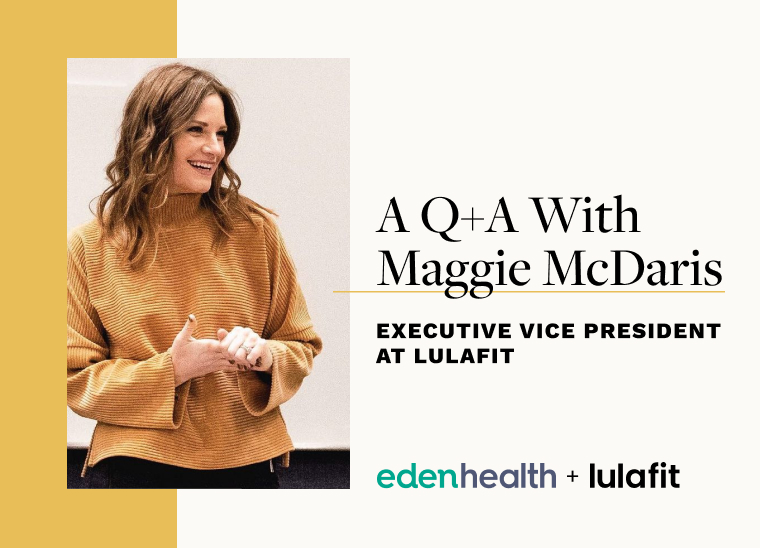As employees make a slow but steady return to offices across the country this spring, tenant safety is top of mind for building owners and employers alike. We spoke to Maggie McDaris, RD, WELL AP, and Executive Vice President at lulafit about the evolving importance of wellness offerings inside office buildings.
Lulafit is a holistic wellness solution that brings a culture of well-being to workplaces and buildings. Individuals and organizations see a boost in employee happiness, engagement, and overall well-being.
Maggie is a registered dietitian and WELL AP-certified, which means that she has a unique perspective on what the best environment should be for employees who work in an office building.
Maggie shared her thoughts on how buildings can thrive in a post-pandemic world. (Hint: It’s not just better ventilation and more natural light.) Keep reading our exclusive Q&A below.

Eden Health: Tell us a little bit more about your background and why you decided to join Lulafit.
Maggie McDaris: My background is in dietetics, public health, and corporate wellness. I joined lulafit in 2017 and realized quickly that my background in public health and community program management was a perfect fit for the wellness operations lulafit was executing for our real estate partners. In 2020, I pursued my WELL AP credential as it became clear buildings have an increasing opportunity to support the well-being of their tenants through the built environment.
Eden Health: What is a Chief Wellness Officer and what services should they provide for tenants?
Maggie McDaris: Chief Wellness Officers are responsible for building a customized, strategic plan to support well-being for their sites. A CWO should assess the needs of their tenants through robust feedback channels and then identify strategic partners (like lulafit) who can then execute on the services, experiences, and technology to support those needs. If involved in the early stages of site development, a CWO should also work closely with property management and development teams to ensure the built environment supports tenant well-being through active design, biophilia (the human instinct to connect with nature and other living beings), and engaging with a WELL AP to explore the option of WELL Building certification and support.

Eden Health: What does a best-in-class workplace community look like?
Maggie McDaris: A best-in-class workplace community is a place where people feel free to show up as themselves. Where employees feel connected to each other through shared goals and experiences whether they are fully remote, in-office, or some combination of the two. It’s a place where employee-based initiatives are a reflection of the diverse needs and interests of the employees themselves. It’s a place where workers are supported by a thriving wellness culture that takes a holistic approach to employee well-being by offering access to resources, coaches, and experiences both in-person and digitally. It’s a place where the foundations of wellness — nutrition, fitness, mental health, empowerment, sleep, and stress-resilience — are supported by company policies and culture.
Best-in-class workplace communities understand that in order for a business to succeed, the individuals within that business must also thrive.
Eden Health: Why is mental health more important than ever and why should employers prioritize this more?
Maggie McDaris: I would argue that mental health is no more important now than in the past. What has changed is the number of people suffering from poor mental health due to the pandemic. Because so many employees are struggling with their mental health, companies can no longer ignore this aspect of employee well-being. Luckily, there are some quick wins employers can deploy to support their employees’ mental health:
- Normalize discussing mental health in the workplace by training people managers to be empathetic and check in with their employees. These managers should feel comfortable modeling healthy behaviors and know which resources to point their teams to.
- Support employees by providing benefits such as access to mental health professionals and coaches. Take it a step further by taking on the cost of these services for your employees to use.
- Where possible, examine policies around PTO, flexible work hours, and communication guidelines to explore how these policies support mental well-being.

Eden Health: What are the best use cases for virtual health and why should employees still leverage virtual health options instead of physically going to their doctor?
Maggie McDaris: Virtual health options ensure flexibility as companies move in and out of remote, hybrid, or in-person models, ensuring access to wellness services remains unchanged. Buildings have an incredible opportunity to leverage technology to extend their wellness amenities to tenants if they are working remotely and then utilize that technology to support a healthy return to the office.
The pandemic has added new burdens to employees, including child care shortages and limited access to public transportation. Virtual health services offer a simple solution to many of the barriers making it difficult for people to physically go to the doctor.
Eden Health: How should landlords and employers be thinking about fitness and nutrition programs at work?
Maggie McDaris: Before employers ask which nutrition and fitness resources they should provide for their teams, they should first ensure that their teams will be able to utilize said resources. For example, if you are providing healthy recipes for your employees to cook at home, make sure there are places to store these healthy meals at the office. Ensure that peers avoid scheduling meetings during the lunch hour to give time to enjoy those meals. Similarly, normalize walking meetings and take time to prioritize physical activity to ensure employees take advantage of whatever fitness programs you offer.
From there, broaden the definition of well-being to provide inclusive and approachable wellness resources. Nutrition services aren’t about cutting calories. Instead, programs should help employees build positive relationships with food and their bodies through things like cooking classes, recipe inspiration, and intuitive eating habits. Fitness offerings should improve the way people move through daily life by offering private and group workouts that enhance overall fitness, boost energy levels, and support ergonomic health.
Landlords have the opportunity to share the burden employers are facing when it comes to the well-being of their tenants. Investing in modern wellness amenities that are inclusive, accessible, and supported by technology allows employers to care for their employees’ well-being simply by being a tenant — an incredible value add for landlords.
Eden Health: What would you like to see in WELL v3 standards?
Maggie McDaris: In WELL v3 I would love to see an even greater emphasis on the continuous programs and offerings buildings provide their tenants. Once you’ve addressed all of the foundational concepts of well-being facilitated by the standard, how are landlords communicating those concepts to tenants and getting them actively engaged in and owning their own well-being journeys? I’d also love to see a greater emphasis on the use of technology. With the hybrid work model becoming more popular, how are buildings extending their well-being offerings into the work-from-home spaces their tenants use?
ABOUT LULAFIT AND EDEN HEALTH
Lulafit helps make company culture thrive. With their proven launch strategy and wellness management expertise, plus digital resources and ongoing support, they take the stress out of building your modern hub of well-being. You can start reimagining your amenities here.
Eden Health provides both in-person and virtual primary care services, mental health support, insurance navigation, and more to tenants nationwide. You can learn more about our direct-to-employer benefit by contacting a member of our team today.





